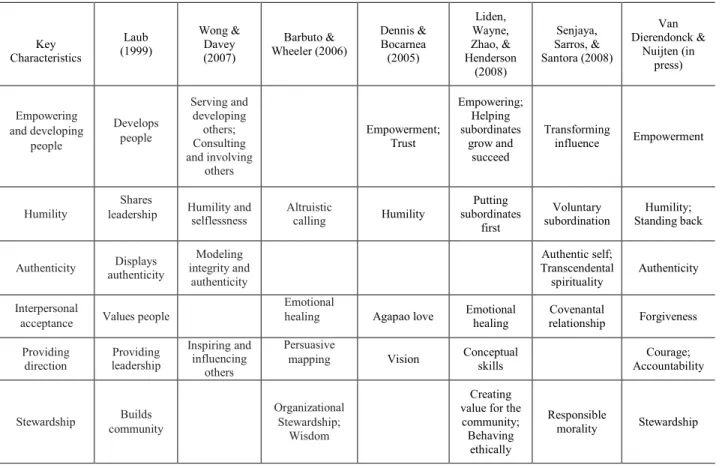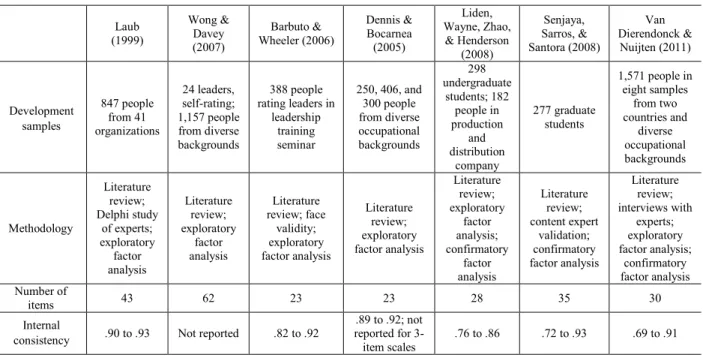The purpose of this study was to validate the results of Ekinci's original research study conducted on the School Principal Servant Leadership Behavior Scale (SPSLBS), a scale that measures the servant leadership behaviors of school principals (2015). The Ekinci scale was developed for use in Turkey and has not been validated for use in the United States. This instrument was chosen because of the importance of having a method of assessing principal leadership that is based on the perceptions of their teachers and because no other servant leadership scale has been developed that specifically looks at servant leadership within educational environment.
The results were promising because the multidimensional structure of the SPSLBS could be replicated with a sample from the United States using confirmatory factor analysis. As in the original study, the factors correlated well enough to be viewed as constructs measuring principals' overall servant leadership behaviors, but differently enough to demonstrate that the scale is composed of individual factors and is not merely a one-dimensional scale. Additional analyzes revealed no significant difference between teachers' perceptions of their principals' servant leadership behaviors based on their gender, which differed from the original study.
Introduction, Literature Review, and Statement of the Problem…
Finally, the newer leadership approach that the current research focuses on includes the servant leadership approach. Servant leadership is contrasted with the autocratic leader and described as a leadership approach that places the well-being of employees above the leader's self-interest (Laub, 2003). Regarding one of the newer leadership approaches described previously, the servant leadership approach, and the NBPEA standards, Brumley (2012) provides a coherent analysis.
Employee management is described with as many as 28 different dimensions, which complicates the research and implementation of the approach (Winston & Fields, 2015). However, the emphasis on serving followers is what separates the servant leadership approach from all other approaches. As mentioned earlier, much of the early research on the servant leadership approach focused on the operationalization of the concept (Van Dierendonck, 2011).
Regarding the instruments developed specifically to measure the servant leadership approach, a variety of methods have been used. Much of the literature on the servant leadership approach is anecdotal in nature, leading many leadership researchers to call for more rigorous quantitative research in this area (Bass, 2000; After a thorough review of the literature, he determined that principals' servant leadership behaviors were not sufficiently researched and tested.
However, Ekinci concluded that the SPSLBS is reliable enough to measure the servant leadership behavior of school principals. Ekinci concludes that gender, as a variable, should be further studied in relation to servant leadership. It is important to have a valid and reliable instrument to measure the servant leadership behaviors of school principals that is based on the perceptions of their teachers.
Dierendonck (2011) in his overview of the measuring instruments used until then for servant leadership. Is the 'School Principals' Servant Leadership Behaviors Scale' (SPSLBS) a reliable measure with a sample from the United States. Do teachers' perceptions of their principals' servant leadership behaviors differ significantly by gender?

Research Design and Methodology
Empathy measures the extent to which the principal demonstrates important characteristics of servant leadership such as interpersonal relationships, active listening and social interactions (Ekinci, 2015). Spears (2010) identifies empathy as one of the dimensions of servant leadership and describes the servant leader as one who treats each person as valuable and believes that each person's feelings and needs should be taken into account. The first part of the study attempted to replicate the original validation study of Ekinci's (2015) "School Principals' Servant Leadership Behaviors Scale" with a sample from the United States.
Confirmatory factor analysis (CFA) was used to determine whether the multidimensional factor structure of the scale could be replicated and to determine whether the scale could be. The second part of the study attempted to determine whether the teacher participants' perceptions regarding their principals' servant leadership behavior, as measured by their responses to the scale, differed significantly according to their gender or according to their length of service with their current principal. After this approval, several school superintendents were contacted by phone and then sent follow-up emails to summarize the discussion and provide the specific details of the research.
Research has suggested that this is a sufficient level to establish factors when considering both the level of commonality of the variables and the level of overdetermination of the factors (MacCallum, Widaman, Zhang, & Hong, 1999). To address the research questions posed in this study, several statistical analyzes were conducted and the multidimensional nature of the principal servant leadership factors was tested. The primary sampling unit consisted of the teachers who volunteered to participate in the study.
Confirmatory factor analysis (CFA) was used to replicate the original validation study of Ekinci's (2015) "School Principals' Servant Leadership Behaviors Scale" (SPSLBS). Structural equation modeling was used to design a model in STATA statistical software for the purpose of the analyses. Chi-square (X2) value was calculated to determine the goodness-of-fit of the model.
All data was handled with extreme caution and attention was paid to maintaining the confidentiality and security of the information.
Results
The Chi-Square value, calculated as a preliminary measure of model fit, was significant (X2=1052.56,df=584,p<0.001) suggesting that the model may not fit the data very well. Therefore, several additional indices were used to provide a more complete picture of model fit considering not only sample size, but also model complexity and other relevant issues related to the study. These include relative or normal chi-square (X2/dfratio), root mean square error of approximation (RMSEA), benchmark indices (CFI and TLI), and residuals (SRMR and CD).
The relative, or normal, chi-square is the chi-square fit index divided by the degrees of freedom in an attempt to make it less dependent on sample size. TheX2/dfratio, calculated to test the five-factor structure validity of the instrument, is 1.80 demonstrating satisfactory model fit. RMSEA, a parsimony-adjusted index, suggests that model fit is moderate or adequate with a lower 90% confidence interval that is greater than the 0.05 cutoff and an upper bound that is less than the cutoff 0.10 (Hooper, Coughlan, & Mullen, 2008).
Given that the chi-square value suggests that the model may not fit the data very well and that additional fit indices yield mixed results ranging from adequate/moderate to very good fit, there is evidence of potential underfitting in the model. Because the standardized factor loadings appear good for each of the factors in question, it seems more likely that the fit indices were influenced by overlap between the factors. The resulting impact on the chi-square value would not justify a change in model structure.
It is reasonable to assume that these five factors would have some similarities, as they are theoretically all aspects of the overarching construct of servant leadership. The results of the ANOVA of teachers' opinions regarding their principal's staff leadership behavior by their tenure with current principals are in Table 11. The mean of teachers' responses to the SPSLBS was compared across four ranges of tenure, including , those teachers employed for less than one year, one to three years, four to six years and more than six years.
Further post-hoc analysis looking specifically at the mean responses for each of the five factors revealed that the significant differences between the one to three year service condition and the four to six year service condition were specifically found to be significant in the Empathy factor and the Justice factor, but not in the Altruism, Humility or Integrity factors.
Discussion
It is reasonable to assume that the five factors would show some similarity since they are theoretically all aspects of the overarching construct of Servant Leadership. Ekinci's (2015) study shows that the scale adequately measures the servant leadership behavior of school principals. Contrary to Ekinci's 2015 study, no significant difference was identified between teachers' perceptions of their school principals' servant leadership behaviors based on their gender.
Ekinci found that male teachers evaluated servant leadership behavior of their principals at a higher level than female teachers. Similar to Ekinci's 2015 study, teacher perceptions of their principals' servant leadership behaviors differed significantly according to their length of service with their current principal. Ekinci's findings indicated that as the tenure of teachers with their current principals increased, their perception regarding the principals' servant leadership behavior increased in a positive direction.
Correlational analysis of servant leadership and school climate.Catholic Education: A Journal of Inquiry and Practice,13(4). Impact of transformational and servant leadership on organizational performance: A comparative analysis. Journal of Business Ethics. Structural equivalence of the Barbuto and Wheeler (2006) Servant Leadership Questionnaire across North American and South African samples.
Development of a scale of servant leadership behaviors of school principals and assessment of servant leadership behaviors according to teachers' views.Egitim Ve Bilim, 40(179) Retrieved from http://ezproxy.alfred.edu:2048/login?url= http: //search.search. An assessment of teachers' opinions about the servant leadership behaviors of school principals. Educational Process: International Journal. Servant leadership: Its origins, development and implementation in organizations. Journal of Leadership & Organizational Studies.
The servant leadership survey: Development and validation of a multidimensional scale. Journal of Business and Psychology. ANOVA Results of Teacher Opinions on Principals' Servant Leadership Behaviors According to Their Tenure of Tenure with Current Principals. Appendix A: School Leaders Scale of Servant Leadership Behaviors Below is a collection of statements describing some key behaviors.
